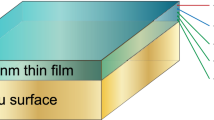Abstract
Staphylococcus epidermidis adhesion onto materials with specific chemical functionalities, under flow, was investigated by using surfaces prepared by self-assembly of alkyl silane monolayers on glass. Terminal methyl (CH3) and amino (NH2) groups were formed by chemical vapor deposition of silanes, at elevated temperature. Carboxyl (COOH) terminated groups were prepared by further modification of NH2 groups with succide anhydride and positively charged NH2 groups by adsorption of poly-l-lysine hydrobromide. Hydroxyl (OH) terminated glass was used as control. Surface modification was verified by contact angle measurements, atomic force microscopy and X-ray photoelectron spectroscopy. A parallel plate flow chamber was used to evaluate bacterial adhesion at various shear rates. Adhesion was found to be depended on the monolayer’s terminal functionality. It was higher on the CH3 followed by the positively charged NH2, the non-charged NH2 groups, the COOH and minimal on the OH-terminated glass. The increase in the material surface free energy significantly reduced the adhesion of a hydrophilic bacterial strain, and this is in accordance with the predictions of the thermodynamic theory. However, the increase in the shear rate restricted the predictability of the theory and revealed macromolecular interactions between bacteria and NH2- and COOH-terminated surfaces.
Similar content being viewed by others
References
Von Eiff C, Peters G, Heilmann C. Pathogenesis of infections due to coagulase-negative staphylococci. Lancet Infect Dis. 2002;2:677–85.
Vincent J-L. Nosocomial infections in adult intensive-care units. Lancet. 2003;361:2068–77.
Vuong C, Otto M. Staphylococcus epidermidis infections. Microb Infect. 2002;4:481–9.
Morra M, Cassinelli C. Bacterial adhesion to polymer surfaces: A critical review of surface thermodynamic approaches. J Biomater Sci Polym Edn. 1997;9:55–74.
Heilmann C, Schweitzer O, Gerke C, Vanittanakom N, Mack D, Gotz F. Molecular basis of intercellular adhesion in the biofilm-forming Staphylococcus epidermidis. Mol Microbiol. 1996;20:1083–91.
Balazs DJ, Triandafillu K, Chevolot Y, Aronsson B–O, Harms H, Descouts P, et al. Surface modification of PVC endotracheal tubes by oxygen glow discharge to reduce bacterial adhesion. Surf Interface Anal. 2003;35:301–9.
Katsikogianni M, Spiliopoulou I, Dowling DP, Missirlis YF. Adhesion of slime producing Staphylococcus epidermidis strains to PVC and diamond-like carbon/silver/fluorinated coatings. J Mater Sci Mater Med. 2006;17:679–89.
Katsikogianni M, Amanatides E, Mataras DS, Missirlis YF. Staphylococcus epidermidis Adhesion to He, He/O2 Plasma Treated PET Films and Aged Materials: Contributions of Surface Free Energy and Shear Rate. Colloids Surf B Biointerface. 2008;65(2):257–68.
Dulcey CS, Georger JH, Krauthamer V Jr, Stenger DA, Fare TL, Calvert JM. Deep UV photochemistry of chemisorbed monolayers: Patterned coplanar molecular assemblies. Science. 1991;252:551–4.
Margel S, Vogler EA, Firment L, Watt T, Haynie S, Sogah DY. Peptide, protein and cellular interactions with self-assembled monolayer model surfaces. J Biomed Mater Res. 1993;27:1463–76.
Scheuerman TR, Camper AK, Hamilton MA. Effects of substratum topography on bacterial adhesion. J Coloids Interface Sci. 1998;208:23–33.
Goldsmith HL, Turitto VT. Reological aspects of thrombosis and haemostasis: Basic principles and applications. Thromb Haemostas. 1986;55:415–35.
Sugimura H, Hozumi A, Kameyama T, Takai O. Organosilane self-assembled monolayers formed at the vapour/solid interface. Surf Interface Anal. 2002;34:550–4.
An Y, Chen M, Xue Q, Liu W. Preparation of self-assembly of carboxylic acid-functionalized silica. J Colloid Interface Sci. 2007;311:507–13.
Vadillo-Rodriguez V, Bussher HJ, Norde W, De Vries J, Dijkstra RJB, Stokroos I, et al. Comparison of atomic force microscopy interaction forces between bacteria and silicon nitride substrata for three commonly used immobilization methods. Appl Environ Microbiol. 2004;70:5441–6.
Busscher HJ, Weerkamp AH, van der Mei HC, van Pelt AWJ, De Jong HP, Arends J. Measurement of the surface free energy of bacterial cell surfaces and its relevance for adhesion. Appl Environ Microbiol. 1984;48:980–3.
van Oss CJ, Good RJ, Chaudhury MK. The role of van der Waals foces and hydrogen bonds in hydrophobic interactions between biopolymers and low energy surfaces. J Colloid Interface Sci. 1986;111:378–90.
Stavridi M, Katsikogianni M, Missirlis YF. The influence of surface patterning and/or sterilization on the haemocompatibility of polycaprolactones. Mater Sci Eng C. 2003;23:359–65.
An YH, Friedman RJ. Laboratory methods for studies of bacterial adhesion. J Microbiol Methods. 1997;30:141–52.
Kamusewitz H, Possart W. Wetting and scanning force microscopy on rough polymer surfaces: Wenzel’s roughness factor and the thermodynamic contact angle. Appl Phys A. 2003;76:899–902.
Mendez-Vilas A, Gallardo-Moreno AM, Calzado-Montero R, Gonzalez-Martın ML. AFM probing in aqueous environment of Staphylococcus epidermidis cells naturally immobilised on glass: Physico-chemistry behind the successful immobilisation. Colloids Surf B Biointerface. 2008;63:101–9.
Bakker DP, Postmus BR, Busscher HJ, van der Mei HC. Bacterial strains isolated from different niches can exhibit different patterns of adhesion to substrata. Appl Environ Microbiol. 2004;70:3758–60.
Finlay JA, Callow ME, Ista LK, Lopez GP, Callow JA. The influence of surface wettability on the adhesion strength of settled spores of the green alga Enteromorpha and the diatom Amphora. Integr Comp Biol. 2002;42:1116–22.
Bayoudh S, Ponsonnet L, Ben Ouada H, Bakhrouf A. Othmane A Bacterial detachment from hydrophilic and hydrophobic surfaces using a microjet impingement. Coll Surf A Physicochem Eng Aspect. 2005;266:160–7.
Boks NP, Norde W, van der Mei HC, Busscher HJ. Forces involved in bacterial adhesion to hydrophilic and hydrophobic surfaces. Microbiol. 2008;154:3122–33.
Katsikogianni MG, Missirlis YF. Interactions of bacteria with specific biomaterial surface chemistries under flow conditions. Acta Biomater. in press.
Ma H, Dickinson RB. Kinetic analysis of the attachment of a biological particle to a surface by macromolecular binding. J Theor Biol. 2004;226:237–50.
Acknowledgments
The authors wish to thank Professor I. Spiliopoulou from the Department of Microbiology, School of Medicine, University of Patras, for providing the bacteria and Dr. E. Siokou from the FORTH/ICE-HT, Patras, for the XPS analysis.
Author information
Authors and Affiliations
Corresponding author
Rights and permissions
About this article
Cite this article
Katsikogianni, M.G., Missirlis, Y.F. Bacterial adhesion onto materials with specific surface chemistries under flow conditions. J Mater Sci: Mater Med 21, 963–968 (2010). https://doi.org/10.1007/s10856-009-3975-y
Received:
Accepted:
Published:
Issue Date:
DOI: https://doi.org/10.1007/s10856-009-3975-y




